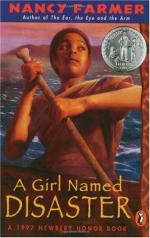|
This section contains 486 words (approx. 2 pages at 400 words per page) |

|
A Girl Named Disaster Summary & Study Guide Description
A Girl Named Disaster Summary & Study Guide includes comprehensive information and analysis to help you understand the book. This study guide contains the following sections:
This detailed literature summary also contains Related Titles and a Free Quiz on A Girl Named Disaster by Nancy Farmer.
A Girl Named Disaster recounts an eventful year in the life of an African girl named Nhamo, the Shona word for "disaster."
Nhamo has spent the first eleven years of her life in a traditional Shona village in Mozambique, where her unloving maternal relatives treat her as a drudge. Her father shamefully ran away after killing another man, and her mother was killed by a leopard when Nhamo was a toddler. Only her grandmother and one female cousin show Nhamo any affection. When cholera strikes, the villagers consult an important traditional healer, who makes Nhamo the scapegoat for all the troubles plaguing the village. To placate the angry spirit of her father's murder victim, the healer decrees, Nhamo must become the junior wife of the victim's brutal brother.
At her grandmother's insistence, Nhamo escapes this dreadful fate by stealing a boat and setting off alone for Zimbabwe to find her father's family. But a journey that was intended to take two days becomes a yearlong odyssey. Nhamo travels the full length of Lake Cabora Bassa, living for several months on an island inhabited by baboons, before she finally reaches Zimbabwe and finds refuge at a science station. Along the way, she faces starvation, isolation, illness, and many physical and psychological dangers. Although she does eventually make contact with her father's people, they are as inhospitable as the relatives she left behind in Mozambique. By the end of the book, however, Nhamo finds a true home for herself among the staff of the science station, who have made her a kind of adopted niece and granddaughter.
The book is written as a third-person narrative from Nhamo's point of view. Since Nhamo initially knows only the traditional Shona life, her perspective may seem alien to Western readers, but unfamiliar terms and cultural practices are carefully defined or explained in the context of the story.
Readers can understand and enjoy the book without any prior knowledge of Africa. A Girl Named Disaster is an excellent introduction to several African cultures. In fact, it was originally intended to be a textbook on African culture, but Farmer wisely decided to turn it into a novel instead. As a tale of adventure, survival, and a quest for home, no remnant of the original didactic impulse remains in the story itself. Factual information that is not intrinsic to Nhamo's story is included in a short glossary of terms, a history of the peoples of Zimbabwe and Mozambique, and an overview of the Shona belief system, in addition to scattered but unintrusive footnotes throughout the novel. The story can be read and understood without recourse to any of this additional information. A love of nature is not a prerequisite for enjoying the book, but it will increase a reader's pleasure in the detailed descriptions of the African landscape. The author is a trained naturalist with an abiding love for the African veldt.
Read more from the Study Guide
|
This section contains 486 words (approx. 2 pages at 400 words per page) |

|



